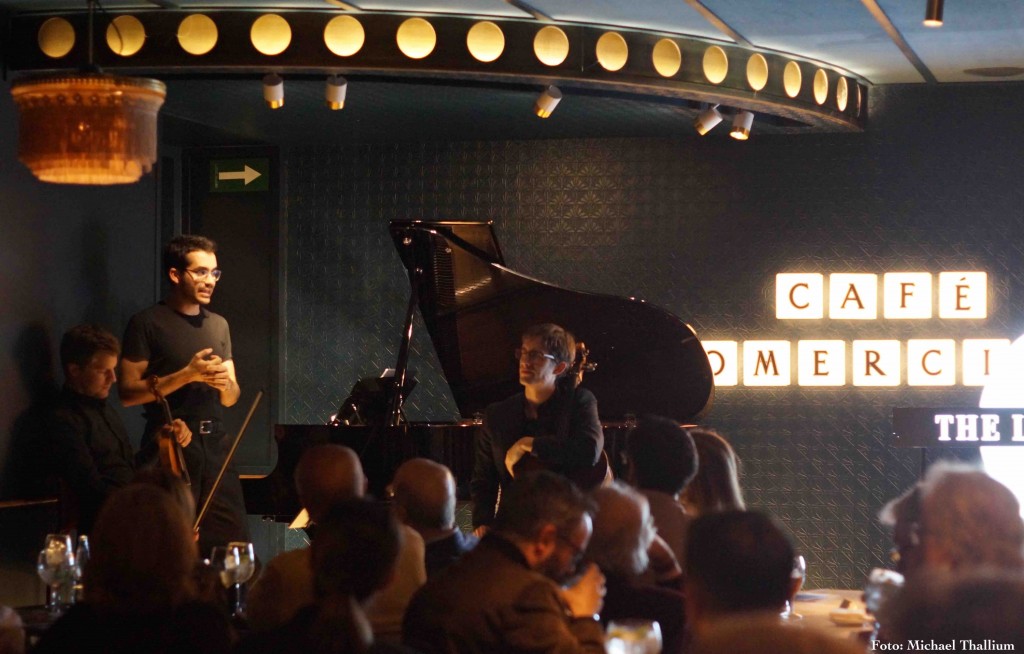Madrid. Café Comercial, 05/12/2018. Trio VibrArt: Miguel Colom (violin), Fernando Arias (cello) y Juan Pérez Floristán (piano). Works of Franz Schubert, Trio No, 2 in E flat major, D929; Dmitri Shostakovich, Trio No. 2 in E minor, op. 67.
By definition, it is impossible to grasp what is ungraspable. And that is what happens “just a little” with that ephemeral art which is music: grasping it becomes impossible. However, —even if we cannot grasp it— that “just a little” is what makes us enjoy music “just a lot”, instant by instant, as time passes by, when the sound waves, by some kind of organic magic, get transformed in our brains and turn into beautiful sounds and harmonic melodies which make us vibrate in tune. Very, very few times that succession of sonic instants turns into truly vibrant art. And that is precisely what the Trio VibrArt achieved at Café Comercial in Madrid. There are moments when you become aware of the transcendence of what you are witnessing, when you realize something is far beyond mere entertainment. I think I am not mistaken by saying that those of us who were witnesses of the Trio VibrArt recital would agree and state that Miguel Colom (violin), Fernando Arias (cello) and Juan Pérez Floristán (piano) created not just good, but exceptional and unique vibrant art. They raised the bar beyond the immense height —and hard to match— of the two composers they performed: Schubert and Shostakovich.
The quality of The London Music N1ghts cycle —sponsored by The London Nº 1— at Café Comercial is growing with each recital. And this is a real challenge for both the artists to come —they are expected to rise the challenge— and the audience attending those recitals —they do not want to be let down. The alma mater of the cycle, Benjamín G. Rosado, hit the bullseye by bringing in the Trio Vibrart to Madrid. On the programme, two chamber music works by two great composers with unmistakable trademarks: the Trio No. 2 in E flat major D929 by Franz Schubert and the Trío No. 2 in E minor op. 67 by Dmitri Shostakovich. These two works are separated by 116 years, but closely connected by the presence of death: Schubert’s work was written in 1828, the year of his death, and it is a real swan song; Shostakovich’s work was written in 1944 amidst the horrors of World War II, it is an anguished song evoking the Jewish holocaust.

Miguel Colom (violin), Juan Pérez Floristan (piano), Fernando Arias (cello).
The first part of the recital started with Juan Pérez Floristán as a master of ceremonies. With that particular high pitch and delicate voice of his —something striking given the strength and powerful character of his hands on the piano—, he explained the first of the works to be performed: Schubert’s Trio. It is a quite well known piece —Stanley Kubrik used its second movement in his 1975 film Barry Lyndon— by the audiences. It has four movements: Allegro, Andante con moto, Scherzo and Allegro moderato. It is a work of exquisite melodical beauty and expressive power. In their days, Schumann and Brahms admired this trio above Beethoven’s trios. It was also one of the last works Schubert could see performed before his passing away. It lasts between 40 to 50 minutes. The Trio VibrArt performed this work with a mental and sentimental inner vision, full of clearness and definition, which surpassed the greatness and highness of the schubertian melopoeia.
The second part of the recital was introduced once again by Juan Pérez Floristán in his own distinct voice. It was an invitation to an epiphany and a catharsis. Shostakovich’s work in four movements, full of Jewish melodies and dances, starts with a delicate and melancholic singing of the cello, in an extremely high pitch —all harmonics and really difficult. Then the violin joins in, in a very low pitch and, finally, the piano accompanies them both. The Trio VibrArt achieved the catharsis: expressiveness, anguish, contrast, dynamism, beauty, sentiment, power, struggle, rapture, delicacy… And lo and behold the epiphany: the three Spanish musicians manifested themselves as a real world reference in trio chamber music.
The enthusiastic applause of the audience, aware of the exceptional performance they had just witnessed, had its reward when the cellist Fernando Arias —interestingly, also with a high pitch and delicate voice that does not match the low pitch and powerful sound of his cello— announced that, as an encore, they would be playing one of Federico Mompou’s Scenes from Childhood arranged for the trio by Juan Pérez Floristán. This short arrangement showed, once again, the musical genius and penetrating intelligence of Juan Pérez Floristán. The Trio VibrArt: vibrant, epiphanic and cathartic!
Michael Thallium
Global & Greatness Coach
Book your coaching here
You can also find me and connect with me on:
Facebook Michael Thallium and Twitter Michael Thallium

Awesome post.